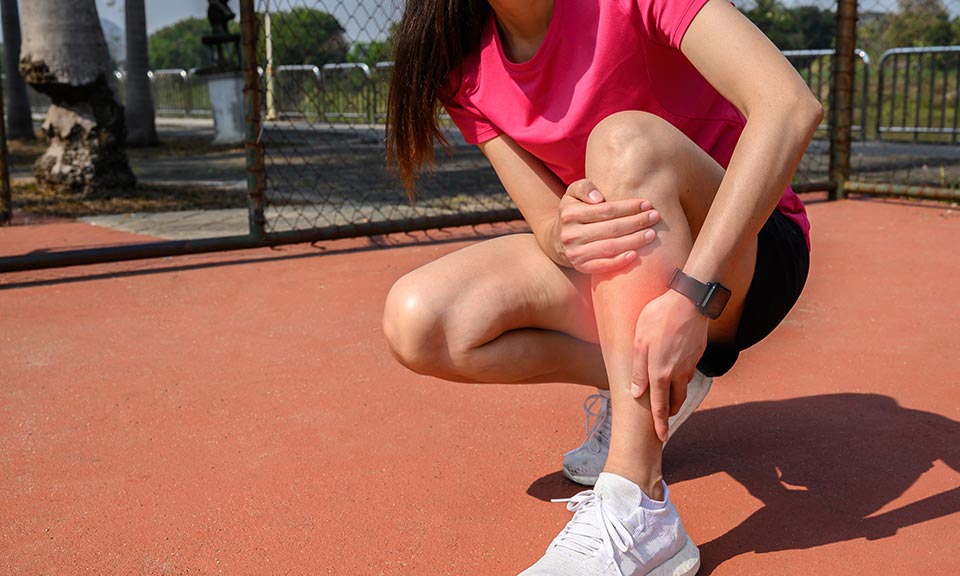RUN BETTER WITH OUR NEWSLETTER
Weekly updates on gear, offers & events
JOIN NOW
The definition of shin splints is pain or tenderness running up the inside, and sometimes the outside of the shin, from the ankle to the knee. They can vary in intensity, from slight discomfort to agonising pain every time you put weight onto your foot. Once shin splints hit, they can play havoc with your training schedule, but don't get disheartened. There are ways to prevent and abolish them for good.
Causes of Shin Splints / Treating Shin Splints / Preventing Shin Splints
In this video are some exercises to help fix shin splints:
Running through the pain is not going to help. Really, at this point you need to stop training and start stretching. It may sound tedious, but it works. The best stretch (given by fantastic Physio, Simon Murphy) for not only the calf muscles, but also the hamstrings and glutes, is as shown above.
Repeat this 10 minutes in the morning and 10 minutes in the evening. For variety, work your legs out into a 'V' shape and then return to hip distance apart.

Put an ice pack onto the shin for 5 minutes. This will get the blood rushing to the inflamed area, and you will recover faster. It's best not to put ice directly on to the skin. You can either put crushed ice in a bag and cover it with a towel, or get a re-usable hot/cold pack.
Shiatsu massage is particularly good, as it targets the pressure points and releases the acute tightness, so that the blood can flow more easily again. You will walk away from the therapist a new person! If you're based in London, Jeanette Houchin is great.
These tools are invaluable in both treatment and prevention. You can alter the amount of pressure on the muscles by leaning more or less body weight onto the area. It is a perfect compliment to stretching as it gets deeper and really gets the blood pumping. Not too comfortable, but productive!
It is very important to get your gait checked. We offer in-store Natural Gait Analysis, or Online Gait Analysis. Sometimes shin splints can come from a lack of anti-pronation support. This is because the arches drop, which in turn puts undue stress on the calf muscle and therefore the shin tendons. Equally, an over-supportive shoe can push the foot over, and result in the a similar pain. Once a shoe is fitted to the foot, they work in harmony together.
When running on harder ground, the impact is higher, therefore you could find it beneficial to add some off-road running into your programme. This will be softer under foot, and less likely to cause problems with your calves.
Stretching is a key part of any running programme. In order to run our best, we need to do the maintenance work. It is best to stretch after exercise, when the muscles have warmed up. On the days when you are not running, still take 10 minutes in the evening to stretch out your calves and quads. This will make your next training session easier, and will help with 'tired leg' syndrome.
See our article: Running Technique to Help Avoid Shin Splints »
Sometimes these are the answer. We'd be happy to advise you on them when you have your gait analysed.
Worn during and post exercise they really help to support the leg muscles and keep the blood flowing nicely to aid recovery.
Q: How long before I can get back to running?
A: Unfortunately, it's impossible to say for sure. It depends on how acute the shin splints are. If you are able to stretch, ice or have a massage, then unless it is a severe case, you should be back training within a couple of weeks. Most importantly, don't give up!
This general information is not intended to diagnose any medical condition or to replace your healthcare professional. The exercises in the video are ones we've found very useful and want to share with our customers. But we're not certified instructors. Always consult your specialist before beginning any exercise programme. Consult with your healthcare professional to design an appropriate exercise prescription. If you experience any pain or difficulty with these exercises or advice, stop and consult your healthcare provider.
Using The GRID® Foam Roller: Self-Massage for Runners
Perfect for injury prevention and rehab, such as ITB syndrome, shin splints, achilles problems, tight quads and hamstrings.
Iliotibial Band Syndrome in Runners
The cause of any running injury can be the biomechanics of the body, wrong footwear, muscle weakness or an over-working muscle. Just so with the IT band.
Running Technique to Help Avoid Shin Splints
Chi Running instructor Balavan Thomas has some useful tips for this common problem.
Best Running Shoes for Shin Splints
While there's no such thing as the perfect trainers to defeat shin splints, depending on the cause, new shoes can make a huge difference.
Leave a Comment